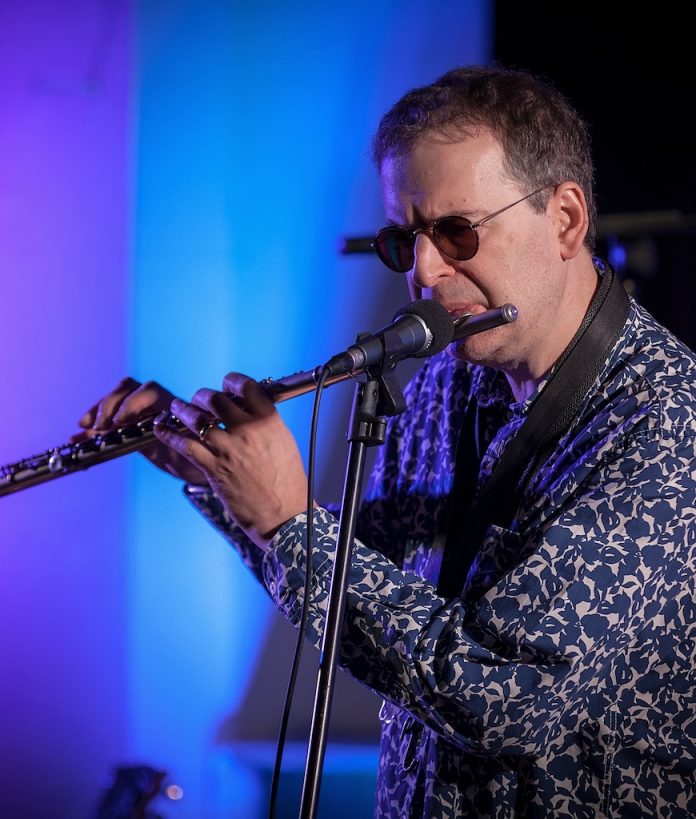“It covers a lot of musical areas that I am involved in and enjoy”, enthuses saxophonist-flautist-keyboard player Theo Travis of Soft Machine’s album Hidden Details. “There’s the more straightahead jazz, there’s the rock side, the free improv side which I particularly enjoy with these guys [guitarist John Etheridge, bassist Roy Babbington and drummer John Marshall] and there’re the sound processing, looping, textural things. And it gave me a chance to flex my writing muscles because I wrote quite a few of the tunes”.
Travis composes variously on piano and computer. “Whatever I can get my hands on”, he laughs. “On my computer I’ve got synthesisers and drum rhythm programming facilities and the great thing about writing on the computer is you can write the bass part, the guitar part and the melody and hear how the parts work together and check that the harmonies and rhythmic lines work. And even if it’s a lifeless electronic version you know from experience what it will be like when you give it to real musicians”.
The album also includes two classic tracks from earlier Soft Machine albums, Out Bloody Rageous (Part 1), from Third, and The Man Who Waved At Trains, from Bundles, both composed by the band’s then-keyboard player Mike Ratledge. “The Man Who Waved At Trains is a great tune”, declares Travis. “It’s got some interesting time signature writing in the melody. Three of us went off and transcribed the [original] record and when we got to rehearsal we all had completely different written versions of what the tune was, where the bar lines were and how many beats were in the bar! But it’s a great tune and the flute gives it a different flavour from the original so we thought it worked well.
“And with Out Bloody Rageous I was particularly keen on the Intro thing that Mike Ratledge does on Third because it’s very close to what I like doing with flutes and saxophones, processing loops and samples. And the tune itself is an interesting melody and rhythmic piece to improvise over”.
The album was recorded in Colosseum drummer-leader Jon Hiseman’s Temple Music Studio and Hiseman, who sadly died soon afterwards, engineered the sessions. “Jon recorded it beautifully and he was extremely organised and efficient”, says Travis. “About 85% of the album was done in two days and on the third day we did a little bit of listening and checking and a couple of overdubs. On the vinyl edition there’s an extra 20 minutes of additional music and we had improvisations that didn’t get used at all so we recorded an awful lot of music in a short period of time.
“But it was very relaxed. Jon’s wife [saxophonist] Barbara Thompson would make these gorgeous soups so we’d have lovely lunches and there were long coffee breaks and an awful lot of stories about people and places and music because Jon had all that experience going back to the mid to late 1960s with Colosseum and Graham Bond.
“He was a great guy. We were there in December [2017] and he was like a teenager. Then in April [2018] he became ill [with a brain tumour] and passed away soon afterwards. It was a shock and we were all devastated”.
Travis also has had a highly creative partnership with King Crimson guitarist Robert Fripp. As Travis & Fripp they have recently released a live triple CD, Between The Silence. “I’m a huge fan of Robert’s and I really enjoy his soundscape work, his Frippertronics”, he says. “I find his music very affecting.
“We did, I think, 21 concerts and we’ve already released some live music, for example Live At Coventry Cathedral. We subsequently did a couple of other albums but it had been a few years so the record label said it would be good to put something else out to keep the band in people’s minds. So I chose three concerts that had been particularly successful and had worked for both of us and were contrasting. One was, I think, the second concert we ever did [in All Saints Church, Broad Chalke], one was in the Bath Festival, in a tent with a bar, and the other one was in this beautiful church [All Saints Church, Cheltenham] where Gustav Holst had been a choirboy.
Robert agreed they’d make a nice package, three concerts for the price of a single CD, to release – which is exactly what happened”.
















